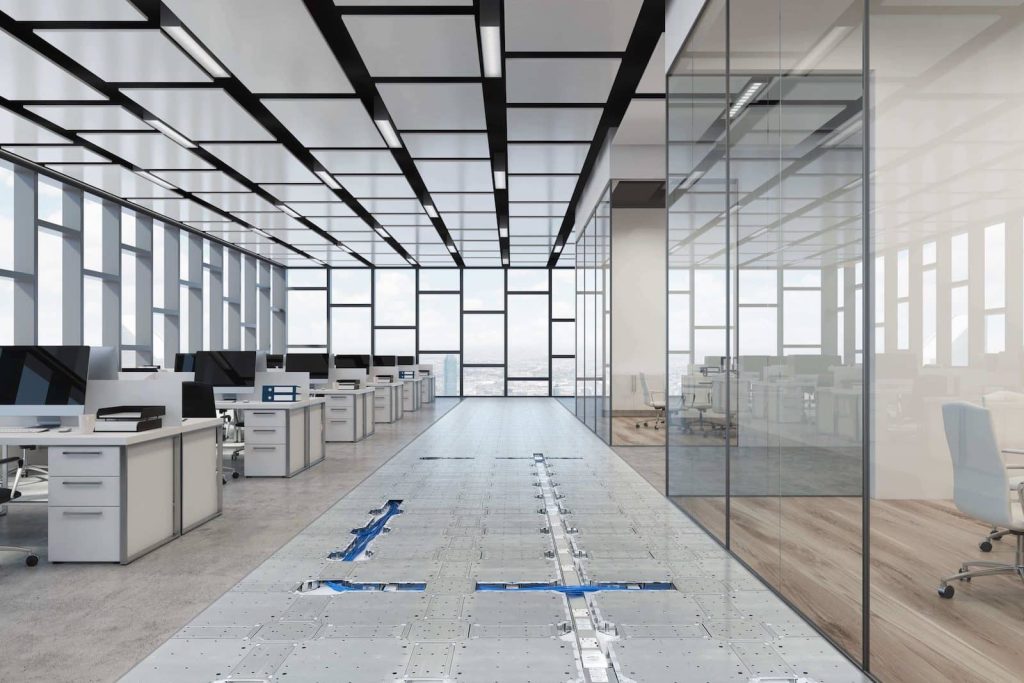Gridd® is the Bridge between Architects, IT & Smart Construction
Infrastructure refers to systems that enterprises put in place to function. It may include physical constructs such as roads and bridges or business processes such as order processing and invoicing. The term also represents the frameworks used to deliver technology to end users. For the most part, these infrastructures live in different worlds.
Governments build, maintain, and control physical infrastructures, even when operated by private companies. Businesses create their operating infrastructures to promote growth. Technical frameworks define virtual constructs by mirroring physical structures digitally. Only recently have organizations realized the significance of a virtual infrastructure in the physical world.
When schools and businesses closed during COVID-19, many parents found themselves hanging out in the library and school parking lots to ensure their children had internet access. Many employers learned their office buildings were unable to support a remote workforce, and employees searched their neighborhoods for high-speed access. A building’s infrastructure became the source for delivering technology at the edge. Edge infrastructure improves performance by locating servers and other computing technologies closer to end users, allowing significantly faster speeds and greater bandwidth availability. Data signals have less competition and have substantially less ground to cover to reach destinations resulting in better network performance.
Moving to the Edge
With this new awareness, businesses and organizations wanting to ensure sustained growth through optimized digital infrastructures would need to move resources closer to the edge. By shifting functionality, organizations realize that by moving infrastructure closer to the end user, they could achieve the following:
- Increased Bandwidth. The more people that access the internet through the same connection, the slower the response time. Moving to the edge reduces the number of people or devices using the same connection.
- Less Latency. Pixelated images require more bandwidth meaning end users experience higher latency. Slow speeds translate to frozen moments during a video call that indicate buffering, but moving signals closer to the end user lowers latency.
- Faster Computing. Edge computing distributes computational resources closer to their endpoints. Rather than send data back to a central server for processing, the edge can manage the information locally for a faster response.
Businesses see better performance and increased productivity after migrating to the edge. Governments deliver key services to more people with a distributed network. However, moving to the edge requires building infrastructures that house the cables and wires to support the technology.
Adding to the Edge
Edge computing has existed since the early 2000s and was not necessarily created with building infrastructure in mind. The principles of edge computing were originally used to create distributed networks for faster delivery of web content. Today, however, the edge has moved beyond content management. The edge is being used to collect data to generate real-time insights that improve operations and sustain growth.
Advanced technologies are fueling the demand for edge capabilities. Organizations need solutions that take advantage of the growing Internet of Things (IoT) and the deployment of artificial intelligence (AI). Growth will require buildings that are equipped to support the capabilities required in the near future.
Providing Edge-like Flexibility within the Existing Infrastructures
The building becomes the core of your connected network because it has become a touchpoint for collecting a wide array of data. As such, it also houses LED lighting, power and data cabling, and sensor systems, providing security, convenience, and connectivity. Ample bandwidth for this increasingly sophisticated array of powered devices (PD) allows the end user direct access to the technologies needed. Increasing power and data access has the effect of improving levels of productivity.
Gridd® Adaptive Cabling Distribution® System, Gridd® Power, and Gridd® Mobile provide entire building infrastructures with the ability to route cables under the floor. Using a patented design, the Gridd system uses adaptable, low-profile components that fit together seamlessly for installation or reconfiguration. The mobile application provides under-the-floor visibility to minimize disruptions and support the advancing wave of connected workplace tools known collectively as the Internet of Things (IoT).
Internet of Things
According to Statista, the number of IoT devices will triple by 2030. Although consumers will deploy 60% of these edge devices, industries will consume the data they provide to become the dominant users of edge computing.
- Healthcare facilities will rely on edge computing to manage the IoT devices used in patient care.
- Food processors will use IoT to monitor the environment to ensure safe food handling.
- Manufacturing will continue to monitor the factory floor to improve operations.
- Utilities will deploy devices to monitor load and predict disruptions.
- Cities will start using IoT as they construct smart cities and buildings.
Organizations will expect that every building will have the infrastructure in place to support their IoT devices and edge computing requirements.
Artificial Intelligence
IoT devices create vast amounts of data, making them a perfect fit for Artificial Intelligence, which requires lots of data to function. AI uses data from IoT devices, websites, and consumer behavior. It consumes significant resources as it digests data and provides results. Rather than send data to a central location, more AI deployments will occur at the edge to take advantage of increased bandwidth and faster response times.
The closer AI is to its data sources, the faster it can ingest, clean, and process information for agile decision-making. With more companies expecting real-time insights, building infrastructure demands will grow until support for these high-performance platforms will be table stakes. IoT and AI are not the only technologies pushing this demand.
Advanced Technologies
5G technology increased the bandwidth and lowered the latency of 4G networks. 6G is expected to use higher frequencies without adding latency. Nanoscale devices are under development to increase computational power at the edge. Cybersecurity is pushing more companies to deploy edge computing solutions to strengthen defenses from cyberattacks.
These technologies represent what is on the horizon. They illustrate the growing need for a built-in infrastructure to address technology’s demands. As businesses continue to explore the benefits of the edge, their expectations will grow. They will demand facilities that are built for and properly utilizing the edge.
Building for the Edge
Edge computing gives organizations the flexibility they need to address an ever-changing business landscape. Adding or relocating edge technologies can happen without disrupting an entire network, ensuring no downtime or lost productivity.
However, creating buildings that function as part of the edge requires the following:
Data. More data means more bandwidth. Buildings must be designed to accommodate growing network requirements for at-the-edge computing. Organizations are depending on rapid processing to deliver real-time actionable insights. They can’t afford inadequate cabling or the delays caused by having them upgraded.
Power. How power is generated and delivered will become a factor in building construction as more industries embrace sustainability. Facilities designed using Power over Ethernet (PoE) or Class 4 power circuits deliver the flexibility edge computing needs.
Performance. Building designs and layouts must adjust to deliver needed performance capabilities. Construction must allow for multiple power sources and high-performance connectivity. Structures cannot limit performance in their design.
Flexibility. Building infrastructures designed for the edge needs flexibility in data and power delivery. Distributed networks give businesses the agility needed to pivot to address market changes. Buildings with adaptive infrastructures will be better positioned to meet technology’s demands.
Building Edge will Put More Control into The Hands of Business
As the edge moves closer to the end user, higher levels of network performance will continue to improve productivity. Robust building infrastructure will provide AI and Machine Learning the bandwidth needed. Finally, flexible deployments enabled by building adaptivity will make the in-person workspace more sustainable, and Gridd makes the process more efficient for business.


